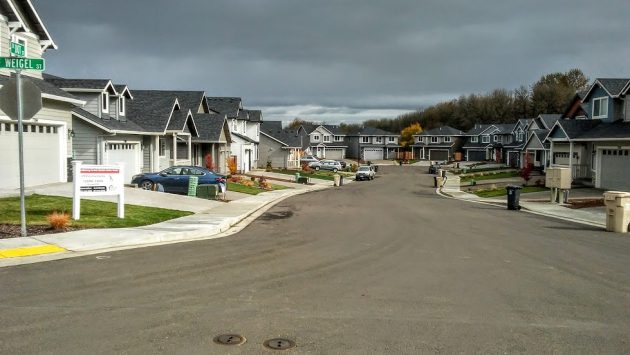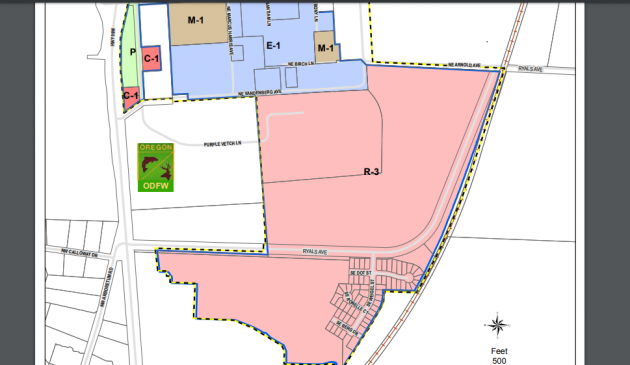
Looking down Dot Street in the new Calloway Creek subdivision in Adair Village on Oct. 21.
In Adair Village, the transformation of the countryside south of Ryals Avenue into suburbia is well under way, as I could not help noticing as I drove by there on Monday last.
The first houses have been sold and look occupied, and construction continues on other streets in this phase of a development called Calloway Creek. I picked up a flier showing 59 lots. On one of the streets, a cul de sac named Dot Street, 16 houses are shown as sold or with sales pending.
The Calloway development was approved by the city about two years ago. Plans for the 41-acre site south of Ryals and east of 99W call for 198 houses. It’s all part of a longtime Adair ambition to become a bigger town in order to attract more services for the people already there. The city’s zoning map shows room for much more housing.
The real estate flier says the location is “ideal for the commuter.” From Adair, it’s six miles to the center of shopping in southeast Albany. (That’s as the crow flies. Cars would have to go a bit farther.) To Corvallis, it’s a straight eight-mile shot down 99W. In the other direction, Monmouth is 12 miles away and Salem 27.
Adair had 928 inhabitants in 2017, according to its transportation plan. The plan says the town expects to have about 1,100 next year, nearly 2,000 in 2030, and a few more 10 years later, in 2040.
Ryals Avenue used to be a sleepy county road. By 2040, the Adair transportation plan projects Ryals to be wider, to have sidewalks, and to serve an additional 3,750 vehicle trips per day, for an increase of 495 percent.
People have to live somewhere, obviously, and the houses at Calloway Creek look really nice. But you’d think that with everybody supposedly worried about our effect on the environment, they’d build houses closer to jobs and shopping so people don’t have so long to drive. (hh)

The pink area on Adair’s zoning map is intended for more housing.



Hasso,
What has become of the idea of staying on Daylight Savings?
Do you know?
Senate Bill 320 passed both houses. A summary provided to a House committee says: “Ceases annual one-hour change in time from standard time to daylight saving time and maintains Oregon on daylight saving time. Exempts portion of state in Mountain Time Zone from permanent daylight time. Makes
change to permanent daylight time in first November after California and Washington elect to maintain
permanent daylight time. Repeals proposed time change if not operative by December 1, 2029.”
California has not acted. Don’t know about Washington.
I live nearby on Independence Highway and have watched this development grow. My greatest concern is that both exits from Ryals, either onto 99 or Independence Hwy, are likely to become collision-prone similar to the various intersections on Hwy 20 between Corvallis and Albany. Additionally the traffic heading to Albany will further choke the intersection where Independence meets Hwy 20 as well as the back-roads through North Albany. Already it can be difficult and time-consuming to turn left onto either highway. As commuters get frustrated by difficult merging and turning dangerous driving increases. More lanes or traffic lights will be necessary to accommodate this added traffic eventually, but how many crashes and deaths will that take?
Population Control is the clear solution. Bring the clutter of humans down to a reasonable level and these problems go away.
The fertility rate in the U.S. is below what is needed for the population to replace itself. So, no control needed there.
https://www.cnn.com/2019/07/24/health/fertility-rate-births-2018-cdc-study/index.html
If what you mean by “population control” is migration, you may have a point. Most of the net migration comes from California. They evidently don’t breed much, but it appears they like the relatively cheap Oregon real estate.
https://www.opb.org/news/article/report-more-people-are-moving-to-oregon-than-leaving/
I’ve found that proponents of that strategy are quite happy to escort others into the abyss, but never volunteer themselves
Will you be exiting any time soon then to keep with your population control measure? Who will decide who stays, who gets terminated? Is it really that crowded in your part of the shire?
The concept seems to have escaped you.
Hope we can ‘stick’ with the script and avoid those who wish to ‘stir’ idle commentary.
I believe the script was lost some time ago. It’s ok though. The “ideal commuter” will become a fallacy since Amazon and their drone deliveries will have us covered.
Who is currently the main developer or builder at Adair Village these days?
That’s Chad E. Davis Construction LLC out of forest Grove, according to the Calloway Creek sales flyer.
Those suburbs are so ugly. More people that would live 10-15 miles away from any school or services, and then urban taxpayers will need to pay for their personal decision to move away from the cities.
Instead we could be promoting modest-home choices in the city, both in Corvallis and Albany, protecting mixed-income neighborhoods, allowing local builders and contractors to remodel homes in the city with homes of all shapes and sizes that don’t need more asphalt and build up, and they are close to amenities.